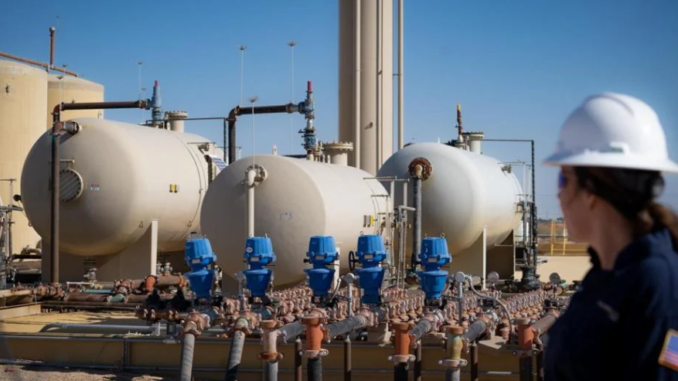
From wellhead to export terminal, Texas’ oil and gas industry is buzzing to new heights, continuing its resurgence after the COVID-19 pandemic’s economic ebb.
Last month, Texas set a new barrel-per-day (mb/d) production record of 5.9 million and withdrew a record amount of natural gas at 34.6 billion cubic feet per day (bcf/d), according to an analysis by the Texas Oil and Gas Association (TXOGA).
“This data confirms the Texas oil and natural gas industry is a powerhouse of production, pipelines, processing and ports, all while continuing to make solid gains in environmental progress,” TXOGA president Todd Staples said in a statement. “Investment in infrastructure by our industry is what enables this high level of performance, which further solidifies the Lone Star State’s position as the world’s energy leader.”
Texas’ share of the U.S. crude oil production has climbed a percentage point this year to 43.4 percent. Its share of domestic natural gas production reached 27.5 percent in 2023.
The production is rising to meet demand, but not just the demand traditionally associated most with petrochemicals — domestic transportation.
Petrochemical products are used in nearly every physical thing made in the world; clothes, cell phones, and tupperware all have petrochemical molecules in them.
Add to that the supply vacuum present in Europe for liquefied natural gas (LNG) as the Russia-Ukraine conflict stretches into its 18th month and winter approaches.
Texas has filled the void and is poised to fill any that arises from the teeming conflict in the Middle East after the attack on Israel last weekend.
The state has exported $124.4 billion worth of energy products this year. The vast majority of the crude oil exported has gone to Europe and the Asian Pacific, while most of its natural gas has been moved to Europe.
A record 5.6 mb/d of crude oil moved through refineries in Texas along with 3.1 mb/d of natural gas liquids.
The state’s refining fleet has been a boon to the economy as crude oil supplies from other states have flowed into Texas facilities for processing, including five billion cubic feet of natural gas in July. Crude oil and natural gas flow in — and gasoline, liquefied natural gas, refined products, diesel, jet fuel, and more flow out.
Texas’ prolific export system — topped by the Port of Corpus Christi — has meant even more commerce for the state. Not only is there a place for product to be processed, but also for it to be moved to consumer markets both domestic and abroad.
“Texas is really critical as a nexus for global processing and trade,” TXOGA Chief Economist Dean Foreman told The Texan. “Geopolitics and having capital investments near war zones is really problematic and will serve as a premium for U.S. exports on a continuing basis.”
Additionally, Foreman said that the industry is poised for 80 percent growth from now through 2030, according to estimates from the U.S. Energy Information Administration.
The continued growth of the state’s energy industry, following the pandemic’s downturn, has contributed to a variety of expenditures made by the Texas Legislature in education, infrastructure, property taxes, and more.
Due in part to higher-than-expected oil and natural gas severance taxes, the Texas Comptroller of Public Accounts announced billions of additional dollars the state has at its disposal compared with the beginning of the year.
As with the rest of the oil and gas industry, Foreman pointed to federal policy as a depressant for growth — something that’s been a consistent theme under the Biden administration, which has a stated goal of reaching net-zero carbon emissions status by 2050.
Foreman said, “With the current geopolitical environment and the domestic crude oil reserves near 40-year lows, it’s imperative that the U.S. have smart energy policies to develop essential U.S. oil and natural gas resources.”



